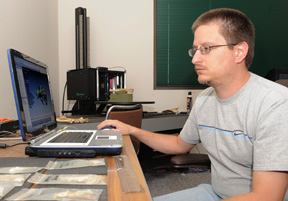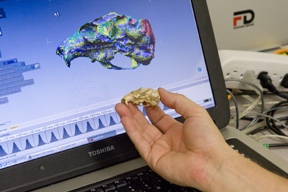ISU researchers developing 3-D virtual archaeological Web site
September 17, 2008
An online, three-dimensional archaeological collection of Arctic animal bones being created at Idaho State University will be an important tool for researchers worldwide from a variety of academic backgrounds.
Furthermore, this effort helps “democratize” science for Arctic research and it showcases an unusual, if not unique, interdisciplinary research collaboration, namely between the ISU Department of Anthropology and the ISU College of Business.
 Herbert Maschner, Ph.D., ISU anthropology research professor, and Corey Schou, Ph.D., professor and director of the ISU Informatics Research Institute and associate dean of the ISU College of Business, are teaming up with Matthew Betts, Ph.D., curator of Atlantic Provinces Archaeology at the Canadian Museum of Civilization and a former postdoctoral researcher at ISU.
Herbert Maschner, Ph.D., ISU anthropology research professor, and Corey Schou, Ph.D., professor and director of the ISU Informatics Research Institute and associate dean of the ISU College of Business, are teaming up with Matthew Betts, Ph.D., curator of Atlantic Provinces Archaeology at the Canadian Museum of Civilization and a former postdoctoral researcher at ISU.
The trio is working with a $310,605 grant from the National Science Foundation for a project titled “The Virtual Zooarchaeology of the Arctic Project (VZAP),” that was awarded to the ISU anthropology department and the ISU Center for Archaeology, Materials and Applied Spectroscopy (CAMAS).

VZAP proposes to develop the world’s first online, interactive, three-dimensional virtual vertebrate reference collection, which will have applications far outside the realm of Arctic research.
“It is a great tool for scientists,” Maschner said. “Instead of having to send a bone to a laboratory at some distant university for identification, researchers will be able to sit at their desk or anywhere they have access to a computer and analyze between 3,000 and 4,000 different bones from about 50 different mammals and a variety of birds from the Arctic.”
Demonstrating a partially completed portion of the project, Maschner displayed how an image of a bone could be called up from the online database and examined. Users can measure the bone’s actual size on the computer screen, and they can rotate the image and view it from as many angles as they like, almost, as if, they were holding the specimen in their hands.
“Anybody who has done excavation in an Arctic archeological site who digs up a bone and needs to identify it will be able to use this program and get a positive ID on what they’re looking at,” Maschner said. “This, in effect, helps democratize science, taking the identification of the these specimens out of the hands of a few specialists. Any student or researcher anywhere will be able to do the same analysis for little or no cost.”
Well-preserved animal bones from archaeological sites are important because they can provide a record of human behaviors, climatic conditions and ecological changes. The primary objective of this project is to develop an online resource for the identification of vertebrate material found in polar archaeological sites. These sites often have excellent organic preservation and produce large amounts of diverse remains from fish, terrestrial mammals, marine mammals, and resident and migratory birds. These remains provide a crucial record of the past – of ancient human behaviors, of earlier climates, and of former ecosystems, Maschner said.
This virtual collection focuses on Arctic species, but many of those species, such as brown or black bears, as well as a large number of bird species, are found in other climates and areas. Thus, the collection will be of use to scientists studying other areas besides the Arctic.
As noted above, the creation of this virtual collection is being carried out through a collaborative effort between the ISU anthropology department and the Informatics Research Institute located in the ISU College of Business. While at other institutions collaborations between an anthropology department and business college are rare, perhaps even unheard of, the two ISU entities mentioned above have worked together on other projects. Those projects include an “artificial intelligence” classification system nicknamed SIGGI, for the Sigmoid Archeological Automated Classification System.
For the Arctic virtual collection project, the ISU Informatics Research Institute is building the software infrastructure, including the image database storage and is creating a secure database meeting federal requirements.
“The Arctic virtual collection is a model for interdisciplinary research on the Idaho State University campus,” said Informatics Research Institute director Schou. “Besides creating a great service for scientists, it gives ISU the best bang for the buck and lets us work with much larger organizations. This isn’t the first time that the IRI has engaged in broad interdisciplinary work with other colleges and departments.”
For more information on the “The Virtual Zooarchaeology of the Arctic Project” visit the Web site http://ivl.imnh.isu.edu/vzapproposal/.
More information on the Informatics Research Institute is available at www.isu.edu/academic-info/crntgrad/informatics.shtml.
Categories:
